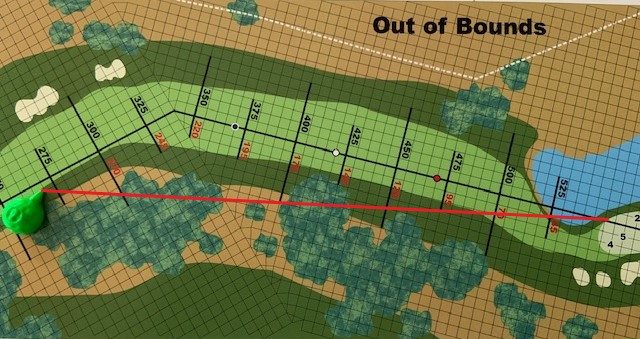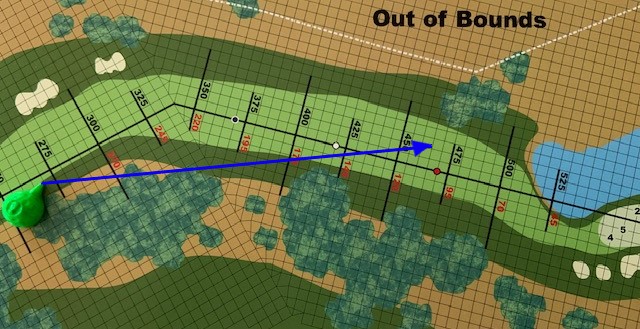I wince anytime I hear someone say something is “common sense.” What they basically mean is, “This is obvious to me and should be obvious to anyone who isn’t stupid.” Well, I assure you history is full of examples where what seemed obvious to people (e.g., the world is flat) turned out to be just plain wrong.
Nevertheless, I’m going to invoke some “common sense” logic when it comes to applying the Master Game rules for doglegs. Let’s look at a specific situation. Here is hole #7, a par 5 at Gopher Lakes, with a severe dogleg 340 yards from the tee.

The ball is sitting at 270 R5 in the intermediate rough (IR). According to the Master Game rules, you draw a straight line from your ball location to the centerline (CL) at the front of the green to determine if you are blocked by trees. In this case, that’s about 280 yards away and over water–well beyond most golfers’ range.
The amount of tree clearance is about 45 yards, limiting me to a 9-iron were I to try to hit “over the trees.” But in some ways that’s a misleading way of even looking at it, since the APBA club boards are oriented to the CL–not the red line I’ve drawn. Of course, you can always pick a longer club and hit around the trees, working the ball back towards the CL. Yet, there is another problem.
This scenario gets much more complicated because of the dogleg. According to the Master Game rules, dogleg effects come into play when you are blocked by trees. That means a ball hit to the right (i.e., inside) of that severe dogleg only 70 yards away will be pushed 5 yards left for every 5 yards past the dogleg! A longer shot could easily go out-of-bounds.
But what would a real golfer do in this situation? Let’s assume the pin location is #4 to the right of the CL. I think he would try to hit a shot to the left of the trees that more or less cancels out the effect of the dogleg and gives him a good angle to the pin. It would look something like this:

The Master Game rules are not totally clear on this point, but I do not consider a ball to be blocked by trees unless the intended path (i.e., the blue arrow) crosses a grid-line that is at least one full square into the trees. I base this on the Master Game rule which states that balls less than one full square into the trees are considered to be in the rough. From a real-world perspective, I see anything less than one full square into the trees as “overhang,” which professional golfers normally navigate quite successfully.
Because the intended path wouldn’t be affected by the dogleg in the real world, I would not apply any dogleg effects. The distance I’m looking for is about 180 yards, so I would use a 4- or 5-iron, depending on my player (and, perhaps, wind conditions).
Aiming is not permitted on second shots on par 5’s unless going for the green, according to the Master Game rules, so I would work-the-ball 10 yards left in accordance with the blue line I’ve drawn. I know many players who would scoff at that rule and say it’s OK to aim to the opposite side of the CL on your second shot on a par 5, as long as you are laying up. (I don’t disagree.)
In any event, you can see how a literal interpretation of the Master Game rules can be problematic in a situation like this. Almost any tee shot less than 280 yards on this hole runs the risk of being blocked. In some cases that’s warranted but surely not all the time. And even if you are blocked, most pros are skilled enough, in my opinion, to not let that dogleg become an insurmountable obstacle.
My advice: Do what makes the most sense to you, have fun, and don’t worry about it.
Makes sense to me. On the other hand what you’re proposing is, it seems to me, is picking a target landing area and aiming directly at it.
I’ve aimed every shot (directly) at a targeted grid intersection for many years. So, for your shot I’d pick the club I needed for 180 yards, aim around any necessary tree clearance and work the ball where it needed to go, then make all my shot corrections off the line you’ve drawn.
Common sense.
By the way, that was a very clear description of the issues that can arise with overly literal interpretation of the rules or simply too many rules.
Nice post.